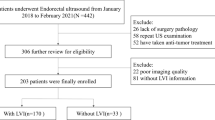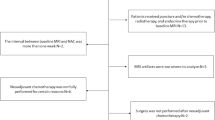Abstract
Purpose
The current study aimed to evaluate the association of endorectal ultrasound (EUS) radiomics features at different denoising filters based on machine learning algorithms and to predict radiotherapy response in locally advanced rectal cancer (LARC) patients.
Methods
The EUS images of forty-three LARC patients, as a predictive biomarker for predicting the treatment response of neoadjuvant chemoradiotherapy (NCRT), were investigated. For despeckling, the EUS images were preprocessed by traditional filters (bilateral, wiener, lee, frost, median, and wavelet filters). The rectal tumors were delineated by two readers separately, and radiomics features were extracted. The least absolute shrinkage and selection operator were used for feature selection. Classifiers including logistic regression (LR), K-nearest neighbor (KNN), support vector machine (SVM), random forest, naive Bayes, and decision tree were trained using stratified fivefold cross-validation for model development. The area under the curve (AUC) of the receiver operating characteristic curve followed by accuracy, precision, sensitivity, and specificity were obtained for model performance assessment.
Results
The wavelet filter had the best results with means of AUC: 0.83, accuracy: 77.41%, precision: 82.15%, and sensitivity: 79.41%. LR and SVM by having AUC: 0.71 and 0.76; accuracy: 70.0% and 71.5%; precision: 75.0% and 73.0%; sensitivity: 69.8% and 80.2%; and specificity: 70.0% and 60.9% had the highest model’s performance, respectively.
Conclusion
This study demonstrated that the EUS-based radiomics model could serve as pretreatment biomarkers in predicting pathologic features of rectal cancer. The wavelet filter and machine learning methods (LR and SVM) had good results on the EUS images of rectal cancer.
Graphic abstract







Similar content being viewed by others
References
Chen L-D, Wang W, Xu J-B, et al. Assessment of rectal tumors with shear-wave elastography before surgery: Comparison with endorectal US. Radiology. 2017;285(1):279–292.
Chen L Da, Liang JY, Wu H, et al. Multiparametric radiomics improve prediction of lymph node metastasis of rectal cancer compared with conventional radiomics. Life Sci. 2018;208:55–63.
Cui Y, Yang X, Shi Z, et al. Radiomics analysis of multiparametric MRI for prediction of pathological complete response to neoadjuvant chemoradiotherapy in locally advanced rectal cancer. Eur Radiol. 2019;29(3):1211–1220.
Pizzi AD, Chiarelli AM, Chiacchiaretta P, et al. OPEN MRI ‑ based clinical ‑ radiomics model predicts tumor response before treatment in locally advanced rectal cancer. Sci Rep. 2021;1–11.
Chen L-D, Li W, Xian M-F, et al. Preoperative prediction of tumour deposits in rectal cancer by an artificial neural network–based US radiomics model. Eur Radiol. 2020;30(4):1969–1979.
Kav T, Bayraktar Y. How useful is rectal endosonography in the staging of rectal cancer? World J Gastroenterol. 2010;16(6):691–697.
Sun Q, Lin X, Zhao Y, et al. Deep Learning vs. Radiomics for Predicting Axillary Lymph Node Metastasis of Breast Cancer Using Ultrasound Images: Don’t Forget the Peritumoral Region. Front Oncol. 2020;10:1–12.
Cusumano D, Dinapoli N, Boldrini L, et al. Fractal-based radiomic approach to predict complete pathological response after chemo-radiotherapy in rectal cancer. Radiol Medica. 2018;123(4):286–295.
Karaoğlu O, Bilge HŞ, Uluer İ. Removal of speckle noises from ultrasound images using five different deep learning networks. Eng Sci Technol an Int J. 2021.https://doi.org/10.1016/j.jestch.2021.06.010
Singh P, Mukundan R, De Ryke R. Texture based quality analysis of simulated synthetic ultrasound images using local binary patterns. J Imaging. 2018;4(1):1–13.
Feng D, Wu W, Li H, Li Q. Speckle noise removal in ultrasound images using a deep convolutional neural network and a specially designed loss function. In: Q. Li et al. (ed) In International Workshop on Multiscale Multimodal Medical Imaging. Springer.Cham. 2019, pp 85–92.
Kaur PP, Singh T. Speckle Noise Reduction in Ultrasound Images. NCCI 2010 -National Conference on Computational Instrumentation CSIO Chandigarh. 2010:198–203.
Ma X, Shen F, Jia Y, Xia Y, Li Q, Lu J. MRI-based radiomics of rectal cancer: Preoperative assessment of the pathological features. BMC Med Imaging. 2019;19(1):1–7.
Shiri I, Hajianfar G, Sohrabi A, et al. Repeatability of radiomic features in magnetic resonance imaging of glioblastoma: Test–retest and image registration analyses. Med Phys. 2020;47: 4265–4280.
Guiot J, Vaidyanathan A, Deprez L, et al. A review in radiomics: Making personalized medicine a reality via routine imaging. Med Res Rev. 2022;42(1):426–440.
Hou M, Sun JH. Emerging applications of radiomics in rectal cancer: State of the art and future perspectives. World J Gastroenterol. 2021;27(25):3802–3814.
Wang S, Huang TZ, Zhao X Le, Mei JJ, Huang J. Speckle noise removal in ultrasound images by first- and second-order total variation. Numer Algorithms. 2018;78(2):513–533.
Saoji SU, Sarode M V. Speckle and Rician Noise Removal from Medical Images and Ultrasound Images. Int J Recent Technol Eng. 2020;8(5):1851–1854.
Duron L, Savatovsky J, Fournier L, Lecler A. Can we use radiomics in ultrasound imaging? Impact of preprocessing on feature repeatability. Diagn Interv Imaging. 2021;102(11):659–667.
Loizou CP, Theofanous C, Pantziaris M, Kasparis T. Despeckle filtering software toolbox for ultrasound imaging of the common carotid artery. Comput Methods Programs Biomed. 2014;114(1):109–124.
Boldrini L, Cusumano D, Chiloiro G, et al. Delta radiomics for rectal cancer response prediction with hybrid 0.35 T magnetic resonance-guided radiotherapy (MRgRT): a hypothesis-generating study for an innovative personalized medicine approach. Radiol Medica. 2019;124(2):145–153.
Delli Pizzi A, Chiarelli AM, Chiacchiaretta P, et al. MRI-based clinical-radiomics model predicts tumor response before treatment in locally advanced rectal cancer. Sci Rep. 2021;11(1):5379-5390.
Lovinfosse P, Polus M, Van Daele D, et al. FDG PET/CT radiomics for predicting the outcome of locally advanced rectal cancer. Eur J Nucl Med Mol Imaging. 2018;45(3):365–375.
Wang J, Shen L, Zhong H, et al. Radiomics features on radiotherapy treatment planning CT can predict patient survival in locally advanced rectal cancer patients. Sci Rep. 2019;9(1):1–9.
Shayesteh SP, Alikhassi A, Farhan F, et al. Author Correction: Prediction of Response to Neoadjuvant Chemoradiotherapy by MRI-Based Machine Learning Texture Analysis in Rectal Cancer Patients. J Gastrointest Cancer. 2020; 51(2):601-609.
Vanithamani R, Umamaheswari G. Speckle reduction in ultrasound images using Neighshrink and bilateral filtering. J Comput Sci. 2014;10(4):623–631.
Jaybhay J, Shastri R. A Study of Speckle Noise Reduction Filters. Signal Image Process An Int J. 2015;6(3):71–80.
Santoso AW, Bayuaji L, Sze LT, Lateh H, Zain JM. Comparison of various speckle noise reduction filters on synthetic aperture radar image. Int J Appl Eng Res. 2016;11(15):8760–8767.
Kupidura P. Comparison of filters dedicated to speckle suppression in SAR images. Int Arch Photogramm Remote Sens Spat Inf Sci - ISPRS Arch. 2016;41:269–276.
Mohd Sagheer S V., George SN. A review on medical image denoising algorithms. Biomed Signal Process Control. 2020;61:102036.
Forman G, Scholz M. Apples-to-Apples in Cross-Validation Studies : Pitfalls in Classifier Performance Measurement. Acm Sigkdd Explorations Newsletter. 2010;12(1):49–57.
Berrar D. Cross-Validation Cross-validation. Encyclopedia of Bioinformatics and Computational Biology 2018;1:542–545.
Purushotham S, Tripathy BK. Evaluation of Classifier Models Using Stratified Tenfold Cross Validation Techniques. International Conference on Computing and Communication Systems. 2012;680–690.
Lee SE, Han K, Kwak JY, Lee E, Kim EK. Radiomics of US texture features in differential diagnosis between triple-negative breast cancer and fibroadenoma. Sci Rep. 2018;8(1):2–9.
Liu Z, Zhang XY, Shi YJ, et al. Radiomics analysis for evaluation of pathological complete response to neoadjuvant chemoradiotherapy in locally advanced rectal cancer. Clin Cancer Res. 2017;23(23):7253–7262.
Horvat N, Bates DDB, Petkovska I. Novel imaging techniques of rectal cancer: what do radiomics and radiogenomics have to offer? A literature review. Abdom Radiol. 2019;44(11):3764–3774.
Huang YQ, Liang CH, He L, et al. Development and validation of a radiomics nomogram for preoperative prediction of lymph node metastasis in colorectal cancer. J Clin Oncol. 2016;34(18):2157–2164.
Gillies RJ, Kinahan PE, Hricak H. Radiomics: Images are more than pictures, they are data. Radiology. 2016;278(2):563–577.
Chen H, Shi L, Nam K, et al. MRI Radiomics for Prediction of Tumor Response and Downstaging in Rectal Cancer Patients after Preoperative Chemoradiation. Advancesradonc. 2020;5(6):1–10.
Jin J, Zhu H, Zhang J, Ai Y, Zhang J, Teng Y. Multiple U-Net-Based Automatic Segmentations and Radiomics Feature Stability on Ultrasound Images for Patients With Ovarian Cancer. Frontiers in Oncology. 2021;18(10):1–8.
Zhou H, Jin Y, Dai L, et al. Differential Diagnosis of Benign and Malignant Thyroid Nodules Using Deep Learning Radiomics of Thyroid Ultrasound Images. Eur. J. Radiol. 2020; 127: 108992.
Qiu X, Jiang Y, Zhao Q, et al. Could Ultrasound-Based Radiomics Noninvasively Predict Axillary Lymph Node Metastasis in Breast Cancer?,” J. Ultrasound Med. 2020; 39(10):1897–1905.
Wang Y, Yue W, Li X, et al. Comparison Study of Radiomics and Deep Learning-Based Methods for Thyroid Nodules Classification Using Ultrasound Images. IEEE Access. 2020; 8: 52010–52017.
DiCenzo D, Quiaoit K, Fatima K, et al. Quantitative ultrasound radiomics in predicting response to neoadjuvant chemotherapy in patients with locally advanced breast cancer: Results from multi-institutional study,” Cancer Med.2020; 9(16):5798–5806.
Dasgupta A, Brade S, Sannachi L, et al. Quantitative ultrasound radiomics using texture derivatives in prediction of treatment response to neo-adjuvant chemotherapy for locally advanced breast cancer. Oncotarget. 2020;11(42):3782–3792.
Rahman MM, Azim M, Mina, Uddin S. Speckle noise reduction in ultrasound images by wavelet thresholding based on subband mean difference. Int J Tomogr Stat. 2012;20(2):91–97.
Bhuiyan MIH, Ahmad MO, Swamy MNS. New spatially adaptive wavelet-based method for the despeckling of medical ultrasound images. Proc - IEEE Int Symp Circuits Syst. 2007;2347–2350.
Theek B, Opacic T, Magnuska Z, Lammers T, Kiessling F. Radiomic analysis of contrast-enhanced ultrasound data. Sci Rep. 2018;8(1):1–9.
Shayesteh SP, Alikhassi A, Fard Esfahani A, et al. Neo-adjuvant chemoradiotherapy response prediction using MRI based ensemble learning method in rectal cancer patients. Phys Medica. 2019;62:111–119.
Acknowledgements
This study was extracted from a Ph.D. thesis from the first author approved by the Tehran University of Medical Sciences. The authors would like to thank the staff of the Medical Imaging and Radiotherapy Oncology centers in Firouzgar Hospital of Iran University of Medical Sciences (Tehran, Iran).
Funding
This work was supported by the Tehran University of Medical Sciences, under Grant No. 49134.
Author information
Authors and Affiliations
Contributions
SA, HAb, and MA contributed to conceptualization, SA, HAb, and SRM contributed to methodology, SA, HAb, HAr, and SRM contributed to formal analysis and investigation, SA contributed to writing and preparation of the original draft, HAb, HAr, MB, AMA, PF, MA, and SRM contributed to writing, reviewing, and editing of the manuscript, SA, MA, and SRM contributed to funding acquisition, AMA and PF provided resources, MA, SRM, and HAr performed supervision.
Corresponding authors
Ethics declarations
Conflict of interest
The authors declare that they have no conflict of interest.
Ethical approval
All procedures performed in studies involving human participants were in accordance with the ethical standards of the institutional and/or national research committee and with the 1964 Helsinki Declaration and its later amendments or comparable ethical standards. The study was approved by the Tehran University of Medical Sciences (No. IR.TUMS.MEDICINE.REC.1399.244).
Additional information
Publisher's Note
Springer Nature remains neutral with regard to jurisdictional claims in published maps and institutional affiliations.
Supplementary Information
Below is the link to the electronic supplementary material.
Rights and permissions
Springer Nature or its licensor holds exclusive rights to this article under a publishing agreement with the author(s) or other rightsholder(s); author self-archiving of the accepted manuscript version of this article is solely governed by the terms of such publishing agreement and applicable law.
About this article
Cite this article
Abbaspour, S., Abdollahi, H., Arabalibeik, H. et al. Endorectal ultrasound radiomics in locally advanced rectal cancer patients: despeckling and radiotherapy response prediction using machine learning. Abdom Radiol 47, 3645–3659 (2022). https://doi.org/10.1007/s00261-022-03625-y
Received:
Revised:
Accepted:
Published:
Issue Date:
DOI: https://doi.org/10.1007/s00261-022-03625-y




